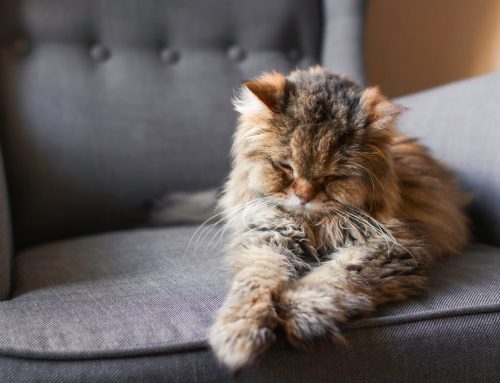America has a serious weight problem—in pets as well as people. Recent U.S. statistics classify about 56% of dogs and 60% of cats as overweight or obese, but unfortunately, the majority of pet owners don’t recognize that their furry pal is carrying excess weight. Our Boca Midtowne Animal Hospital team wants your pet to live a long, happy life, so we explain why pet obesity is problematic and offer advice to keep your pet at a healthy weight.
Pet obesity defined
Obesity is defined as a clinical condition characterized by excessive body fat accumulation that leads to pathology and/or impaired function. Pets are considered overweight when they are 10% to 30% above their ideal body weight and obese when they exceed 30% of their ideal body weight.
Pet obesity complications
You may think your pet’s roly-polyness is cute, but being overweight can result in serious health complications for your four-legged friend. Some common issues associated with excess weight include:
- Osteoarthritis — Excess body weight increases mechanical forces placed on joints, exacerbating cartilage degeneration and arthritis pain. In addition, adipose tissue (i.e., fat) produces inflammatory mediators that aggravate joint inflammation.
- Diabetes — Obese cats commonly develop diabetes, and obese dogs are also at increased risk. In overweight pets, the body cells are more resistant to insulin, which leads to hyperglycemia.
- Kidney disease — Obesity alters renal function and can contribute to kidney disease in pets.
- Cancer — Adipose tissue contains numerous blood vessels and creates inflammation throughout the body that can promote cancer development.
- High blood pressure — Excess fat increases vascular resistance, so the heart has to work harder to pump blood, resulting in high blood pressure.
- Mobility issues — Activity is more difficult for overweight and obese pets.
- Respiratory issues — Excess chest and abdominal cavity fat can inhibit breathing, leading to respiratory difficulty and fatigue.
- Skin conditions — Skin folds develop in overweight and obese pets and provide an excellent environment for pathogens, such as bacteria and fungi, potentially leading to skin infection.
Pet weight status assessment
Scheduling an appointment with our Boca Midtowne Animal Hospital team is the best way to determine whether your pet is overweight or obese. We will not only weigh your pet, but also assess their body condition score (BCS), which is a grading system that provides an objective measurement of your pet’s weight. Factors evaluated include:
- Ribs — We should be able to feel your pet’s ribs without excessive pressure.
- Waistline — We look at your pet from above while they are standing—they should have a defined waistline that curves in behind the rib cage and is shaped like an hourglass.
- Profile — We look at your pet from the side while they are standing—their abdomen should slant upward from their rib cage to their back legs.
- Specific points — We palpate your pet’s backbone, legs, hips, and pelvis, feeling for excess fat layers.
If your pet is overweight, our team will devise an appropriate, safe weight-loss strategy. Prescription commercial weight-control diets are often helpful for overweight and obese pets, because they keep them satiated while they lose weight. Suddenly restricting your pet’s calories without veterinary guidance can be dangerous and result in serious health complications, so always consult our team before changing your furry pal’s diet.
Pet weight management

Tips to help keep your pet at a healthy weight include:
- Scheduling regular wellness visits — Annual or bi-annual wellness visits help our team track your pet’s weight and detect conditions that may contribute to weight gain before they cause your pet a problem.
- Weighing your pet — Weigh your pet regularly on a baby scale, so you can monitor their body weight.
- Calculating your pet’s caloric needs — Consider your pet’s breed, age, activity level, and spay or neuter status to accurately calculate their daily caloric needs. Online pet calorie calculators that make the process easier are available.
- Measuring your pet’s meal portions — Use a measuring cup or a kitchen scale so your pet’s meal portions are measured accurately, to ensure they receive the correct amount. A few extra pieces of kibble can be a large percentage of extra calories for your cat or small-breed dog.
- Limiting treats — Limit your pet’s treats to 10% of their total daily calories and remember to reduce their meal portion to compensate for treats.
- Exercising your pet — Ensure your pet gets adequate physical exercise. If they spend most of their time sleeping on the couch, start with short walks around your neighborhood, and gradually increase the exercise duration and intensity as they become more fit. Also, don’t forget that cats need exercise, too. Get your cat up and moving with a wand-style toy or laser pointer, and schedule 10 to 15 minutes of play twice a day.
- Using a food puzzle toy — Use a food puzzle toy to make mealtimes more entertaining, which will prevent your pet from gulping down their meal.
- Choosing healthy treats — Avoid high-fat treats, and instead reward your pet with healthy alternatives such as vegetables and fruit.
Contact our Boca Midtowne Animal Hospital team to schedule a weight assessment for your pet, so we can ensure they are fit, svelte, and at an ideal BCS.







Leave A Comment